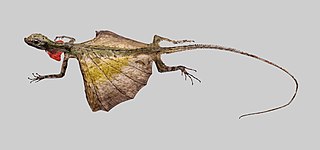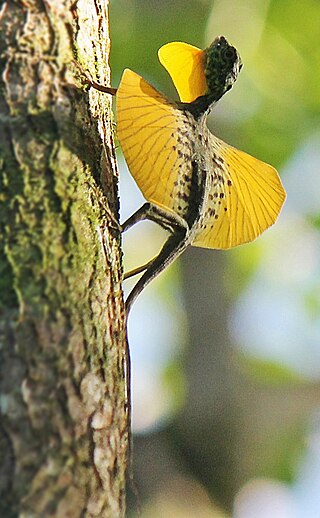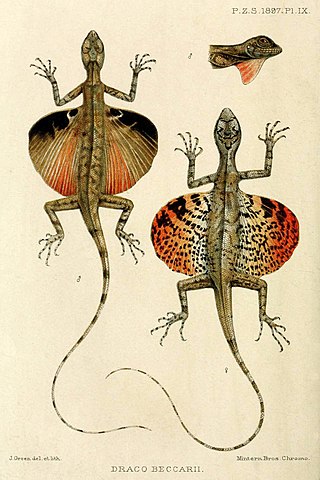
Agamidae is a family of over 550 species of iguanian lizards indigenous to Africa, Asia, Australia, and a few in Southern Europe. Many species are commonly called dragons or dragon lizards.

Draco is a genus of agamid lizards that are also known as flying lizards, flying dragons or gliding lizards. These lizards are capable of gliding flight via membranes that may be extended to create wings (patagia), formed by an enlarged set of ribs. They are arboreal insectivores.

Draco volans, also commonly known as the common flying dragon, is a species of lizard in the family Agamidae. The species is endemic to Southeast Asia. Like other members of genus Draco, this species has the ability to glide using winglike lateral extensions of skin called patagia.

Draco blanfordii, commonly known as Blanford's flying dragon, Blanford’s flying lizard, or Blanford's gliding lizard, is a species of "flying" lizard in the family Agamidae. The species is endemic to Asia, and is capable of gliding from tree to tree.

Draco dussumieri, also known commonly as the Indian flying lizard, the southern flying lizard, and the Western Ghats flying lizard, is a species of lizard in the family Agamidae. The species is capable of gliding from tree to tree. It is found principally in the Western Ghats and some other hill forests of Southern India. It is almost completely arboreal, found on trees in forests and adjoining palm plantations where it climbs trees to forage for insects and glides to adjoining trees by expanding the patagium, loose skin on the sides of the body which is supported by elongated ribs to act as wings. The skin on the sides of the neck is also extended to the sides using the hyoid bones of the tongue as support. During the breeding season males maintain small territories which they defend from other males while courting females. The male has a more colourful patagium than the female, and it prominently extends its yellow dewlap forward in display. Although living almost its entire life in trees, the female descends to the ground to lay eggs in soil. This is the species with the westernmost distribution within the genus Draco, the majority of species occurring in Southeast Asia.

Draco maculatus, commonly known as the spotted flying dragon or spotted gliding lizard, is a species of agamid flying lizard endemic to Southeast Asia. It is capable of gliding from tree to tree.

Draco norvillii, also known as Norvill's flying lizard, is species of agamid flying lizard endemic to India. This species is capable of gliding from tree to tree, and has been recorded gliding up to 50 metres (160 ft). It feeds on insects and other small invertebrates.

Draco sumatranus, the common gliding lizard, is a species of agamid lizard endemic to Southeast Asia. It has elongated ribs and skin flaps on the sides of its body. When opened, these skin flaps allow it to glide between tree trunks.

Draco indochinensis, also known as the Indochinese flying lizard or Indochinese gliding lizard, is a species of agamid lizard endemic to South-east Asia.

Karvalo is a novel written by Poornachandra Tejaswi, a Kannada writer whose works include novels, short stories, non-fiction and poetry.

Draco mindanensis, commonly known as the Mindanao flying dragon or Mindanao flying lizard, is a lizard species endemic to the Philippines. Characterized by a dull grayish brown body color and a vivid tangerine orange dewlap, this species is one of the largest of the genus Draco. It is diurnal, arboreal, and capable of gliding.
Draco guentheri, commonly known as Günther's flying lizard is a species of "flying dragon" in the family Agamidae. The species is endemic to the Philippines.

Draco spilonotus, the Sulawesi lined gliding lizard, is a lizard endemic to Sulawesi. The species is known from various localities in forested areas of Sulawesi.
The Aurora mountain skink is a species of lizard in the family Scincidae. The species is endemic to the Philippines.

Acanthocercus adramitanus, also known commonly as Anderson's rock agama or the Hadramaut agama, is a small species of lizard in the family Agamidae. The species is endemic to the Arabian Peninsula.

Draco beccarii is a species of lizard in the family Agamidae. The species is endemic to Indonesia.
Draco boschmai is a species of lizard in the family Agamidae. The species is endemic to Indonesia.
Draco iskandari is a species of lizard in the family Agamidae. The species is endemic to Indonesia.

Draco spilopterus, the Philippine flying dragon, is a species of agamid lizard. It is found in the Philippines and Indonesia.

Gonocephalus liogaster, also known commonly as the blue-eyed anglehead lizard, the orange-ringed anglehead lizard, and the tropical forest dragon, is a species of lizard in the family Agamidae. The species is native to Southeast Asia.

















